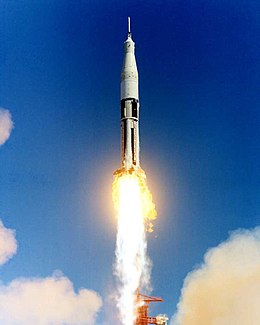This article includes a list of references, related reading, or external links, but its sources remain unclear because it lacks inline citations. (February 2011) |
 Launch of AS-201, the first flight of the Apollo spacecraft and Saturn IB launch vehicle | |
| Mission type | Suborbital test flight |
|---|---|
| Operator | NASA |
| Mission duration | 37 minutes, 19.7 seconds |
| Range | 8,477 kilometers (4,577 nautical miles) |
| Apogee | 492.1 kilometers (265.7 nautical miles) |
| Spacecraft properties | |
| Spacecraft | Apollo CSM-009 |
| Manufacturer | North American Aviation |
| Launch mass | 15,294 kilograms (33,718 lb) |
| Start of mission | |
| Launch date | February 26, 1966, 16:12:01 UTC |
| Rocket | Saturn IB SA-201 |
| Launch site | Cape Kennedy LC-34 |
| End of mission | |
| Recovered by | USS Boxer |
| Landing date | February 26, 1966, 16:49:21 UTC |
| Landing site | South Atlantic Ocean 8°56′S 10°43′W / 8.933°S 10.717°W |
AS-201 (Also known as SA-201, Apollo 1-A, or Apollo 1 prior to the 1967 pad fire), flown February 26, 1966, was the first uncrewed test flight of an entire production Block I Apollo command and service module and the Saturn IB launch vehicle. The spacecraft consisted of the second Block I command module and the first Block I service module. The suborbital flight was a partially successful demonstration of the service propulsion system and the reaction control systems of both modules, and successfully demonstrated the capability of the command module's heat shield to survive re-entry from low Earth orbit.